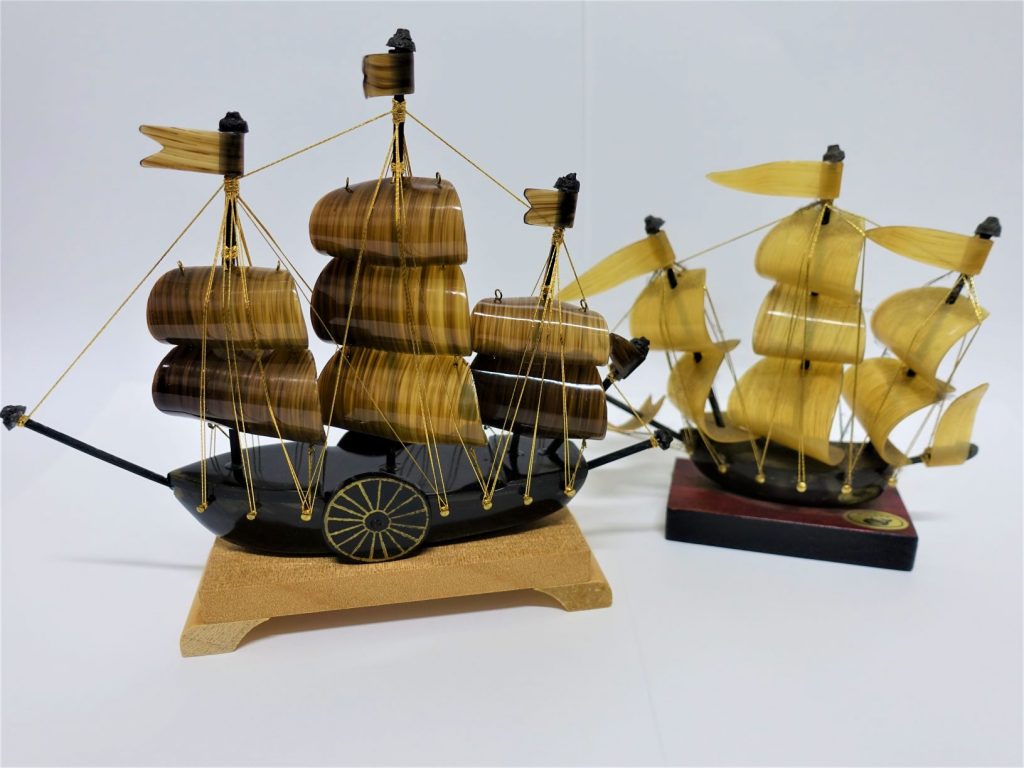The Institute of Cetacean Research (ICR) contributes to research on whales and other sea mammals, as well as the sustainable use of marine resources. As part of its outreach activities, the ICR is often involved in events and special exhibitions connected to whales, and has received a variety of donated artwork and other items since it was founded. In addition, its workers often purchase rare whale-related items while traveling or on business trips.
As a result, the ICR now has a wide-ranging collection of unique whale objects, both modern and antique, from many corners of the globe. In this series of articles, we will gradually introduce items from this collection.
We begin with Japanese artwork and crafts made from whale baleen.
Baleen, also known as whalebone in the West and kujirahige (whale whiskers or mustache) in Japan, is actually neither of those things. It is, for instance, unrelated to the whiskers that grow around the mouths of animals such as cats and dogs.
Whales are divided into two closely related groups: 14 species of “baleen whales” and 75 species of “toothed whales.”
In the former group, baleen grows in 200 to 400 narrow, triangular plates attached to the upper jaw, arranged like the prongs of a comb. As for their purpose, the baleen serves as a filter inside of the mouth of a whale, filtering out small fish and krill from ocean water.
Baleen is composed of keratin, the same material found in our fingernails. Because it is very light, and relatively hard, yet flexible, it has been used for various purposes since antiquity. For example, it was traditionally used for the springs in Japanese mechanical dolls, and is still used in items such as fishing rods.
The sailing ships below are made from baleen. In the single ship shown in a photograph of its own, minke whale baleen is used to give the ships’ sails an animated appearance. At the same time, the color of baleen varies among different species of whales, adding character to the artworks in which it is used. The differences are evident in the image of two ships. The material used for the sails in the piece on the left is fin whale baleen, while the body is made of sei whale.
Viewed up close, the natural beauty of the baleen is clear on the sails shown in the closeup image (upper right or center, depending on your viewing platform.)
Next we have images of two angelfish that were made from the fin whale baleen. The design below the fish in the closeup image is also made from baleen.
In the following images, we have a set of plates and forks made from the baleen of a fin whale. This type of souvenir set was even presented as a gift to the Emperor of Japan! The clamshell shaped objects are meimeizara (small plates for individual helpings of food such as Japanese sweets (wagashi). If you look at the wagashi fork cutters, also made of baleen, the area behind the forks has a stylish whale motif.
In the next item, a paper knife in the collection is made from baleen, the head serves as the handle.
The next item is a rare example of a traditional Japanese shingenbukuro pouch (cloth bag) that is made using baleen. The baleen has been split into slender pieces and woven to form the base of the pouch.
Below is a model of a sekobune whaling boat made from various kinds of baleen from the era of whale net fishing during the Edo Period. Whale fleets during this era consisted of such boats, which carried harpooners, as well as other varieties of vessels such as the amibune net boats. The designs painted onto the boats identified the roles of their occupants in the hunts.
The final piece is a whale model made of baleen from a fin whale. It has a lovely rounded shape.
So what did you think of these items, and the way they accentuate the natural beauty of baleen?
They are sometimes found in Japanese homes, where their subtle character adds elegance to an entryway or living room. Within Japan they can even be found on online auction sites and in small shops, a window into one of the country’s unique art traditions.
(This article is published in cooperation with the Institute of Cetacean Research. It was first published in Japanese by Kujira-Town. Let us hear your thoughts in our comments section.)
Author: Institute of Cetacean Research
